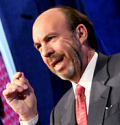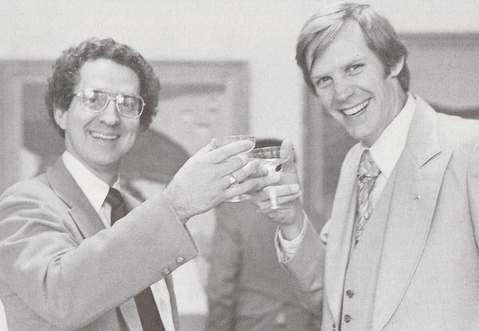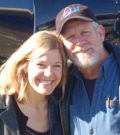
Ron Ponder
CIO, FedEx
| Back to FedExLegends HomePage | Last Updated: Jul 6, 2011 |
Operations Research @ Federal Express
In 1962 while home from college, Fred Smith met a physicist also home from college named Charlie Brandon. Before operations started in 1973, FWS engaged Charlie as a consultant to find out if computers could be used to design a system form and schedule aircraft for small package delivery. Charlie became the pioneer in this endeavor. This developed into a large operations research group who worked on everything from how many hubs is optimum, to price larger aircraft needed to be, economically, to scheduling routes on the ground, pilot scheduling, international planning and optimum customer service scenarios, and a host of other endeavors. It became a pivotal resource in making decisions for the company and reported to FWS directly. Charlie became the VP of Operations PlanningCharlie hired Dr. Ron Ponder in 1974 who built this department. Joe Hinson, Ron's student at the time, came aboard as a contractor and he became an employee the next year. When Ron Ponder was promoted to SVP/CIO of Info Systems, Joe became the VP of Operations Planning.
|
|
Ron Ponder CIO, FedEx |
An Interview with Ron Ponder, Part I
April 20, 2011
| Currently being Revised. |
Antony Kong
Dr. Antony Kong transferred out of Operations Research in the mid 1980's to Telecom, then Satellite Sytems and eventually into Computer Operations. In the Satellite Systems group, his department (which included Kay Moody, John Dewey and others) ran large computer models on how a future Zapmail system would work where customers had small satellite dishes on their rooftops. They also ran costing models on what the system would eventually cost. Antony's group worked long hours at night when they could get more computing time on the mainframe, and then would also be there during the day to analyze their results. Antony's group eventually transferred to Computer Operations under VP Ed White. The constantly ran analytics to measure performance of the IBM systems and how to tune for better performance. Antony left FedEx in the 1990's and is not CIO/CTO of Asurion based in Hong Kong. |
Harry Dalton & Tom Bullion circa 1979 ; scanned from a FedEx Update newsletter courtesy of Charlie Derrick
|
 |
 |
Tom & Laura Bullion |
Tom began his career at FedEx in 1973 and was employee 920. Federal Express Initial Concept FWS's initial plan was to start FedEx service by flying Federal Reserve checks from major cities to check clearing locations, then fly the sorted checks back to the original banks. For this reason the company was named Federal Express. A problem with the plan was the many of the banks had long term contracts with many contract air carriers to transport their checks and couldn't break those contracts, to sign on with Federal Express. It wasn't till FWS engaged Art Bass and Vince Fagan that the idea of making Federal Express the package transportation system like UPS was flushed out. Vince came up with the idea that we were a trucking company whose trucks travelled at 550 miles per hour. FedEx Corporate Colors The Falcon jets were initially painted Red, White and Blue but the Post Office sued the company saying that those were the colors of USPS. So, Federal Express changed colors to Purple, Orange and White. The General General McNeally was known for edicting that he have his own personal bathroom and personal parking space and other perks. He tried to get together his own investment group to take over FedEx stock, but this failed and FWS eventually fired him. Rating, Scanning, Customer Service, Dispatching Tom worked on most of the original concepts that made FedEx great. He wrote one of the original rating Cobol programs, so that we could give customers rates on services and help locate exception packages. He also worked with Memphis programmers like Chuck Graham and they worked the original scenario to move Customer calls for pickups from the stations to a centralized call center, because calls were overloading manpower at each station. The original prototype was called DIC-Aids (Delivery Information Center – Automated Information and Dispatch System and ran on the Burroughs 6700. Mr. Smith loved the demonstration but paled at DIC-AIDS and wrote COSMOS on a napkin at the Sawmill. This became COSMOS SYSTEM. Tom worked with Bob Higgins and others in Colorado Springs to plan COSMOS transfer to ACP on IBM mainframes, and to begin working on a system to track the packages. Federal Express wanted to give proof of delivery and attach to the customer's invoice. One part of the signed airbill from the delivery was keyed when returned from the courier. One of the early concepts to track packages was an airbill with colored rings on it, where the courier would tear off and put on a belt, the rings would be returned and info on them keyed. In initial discussions, Tom knew that this would be a burden on the couriers. Larry Stoltenburg (who had been hired in Memphis & transferred to Colorado Springs) came up with the idea to put bar codes on the airbills and use scanners to verify delivery. Larry's manager though, was a proponent of the ring solution, and Larry was fired. Eventually though, this manager was fired, and the bar code scenario went forward. One of the initial problems was how to get bar codes and make numbers for every airbill different. Janice McNeal found a German company who produced print wheels that could index the number and figure the mod-7 check digit fast enough to print these new airbills. That is the initial solution the company went with. Tom then worked with Intermec, Norand and others to see what technology was out there and they came up with a 12 city test scenario. Some of the locations would test full functionality (ie end to end scanning) and others would use basic scans to start the process.
There wasn't a lot of scanner technology in the late 70's, and Tom selected Norand to start the initial tests. Knowing that the labor of scanning these airbills would be onerous to the couriers, and just something else they had to do; Tom discussed this issue with Mr. Pete Willmont and said we really need someone from the field, who can interface to the field and push the tests and for the field to do the tests. The person selected was a District Director named Harry Dalton. Harry was well respected by the field and he relocated to Colorado Springs to work with the software development team, and eventually moved to Memphis. Tom remembers the early testing. In a skydiving incident, his parachute failed to open, but when he landed, he fortunately landed on his back, on his parachute backpack. He did break his back in 6 places but survived. As he was recovering Harry visited him and wanted to know if or when he could travel. Tom was the only one who knew how to execute the test plan. The 12 city test had been scheduled and since Tom was the project lead, and had all the info, Harry needed him to travel. Tom relayed that he indeed did travel, and helped Harry, and Harry helped him by carrying his bags giving him some of his pain medicine… After testing it was decided that the full blown software (IIA) was too onerous so COSMOS IIB project was funded and deployed. FedEx would scan packages in and out of Stations, delivery and exception. Container scans and scans and in and out of the Memphis Hub were put on hold. After Tom deployed the scanners, when a customer called about a package, Customer Service could tell them what city it was actually in. After IIa, Tom transitioned the tracker inventory and management to Jimmy Sowell (see Jimmy Sowell video). International After COSMOS IIB Tom transferred to International working with Jim Dunkel. FedEx was starting to expand into Canada. FedEx would fly packages to a Cleveland, OH, transfer packages to Air Canada. Air Canada would fly to Canadian cities and hand off to a delivery company called Canseca. One of the initial problems was how to use zip codes for the destination address. The US zip code used 5 numeric digits. Canada used 6 digits which could be alpha or numeric. Tom worked with the billing staff to come up with a translation table using dummy zip codes. Eventually Air Canada decided they didn't want to be in the package business, and FedEx started flying the Falcons into Canada. Business just went vertical and growth was at a fast pace. Tom was working with Customs, but no one at FedEx was an expert in customs. He posted a job nationwide and received about 27 resumes. As he was going thru the stacks of resumes, one kept falling on the floor and he kept picking it back up and putting it into the large stack. He finally picked it off the floor again, and looked at it closely. He liked what he saw, and called this guy named Al Basemore who had just retired from Customs. Tom said something like " I'm Tom Bullion from Federal Express and I just got your resume….is anything in it true?......" Tom hired Al on the spot. Clearance In 1982 FedEx was transmitting facsimile manifests to Customs, but clearance was slow. Tom talked to one the Customs officials up north about how they can speed this up. The Customs guy relayed well there was one computer system they were using in Miami that pre-cleared packages from Latin America. Information about trusted shippers was sent before the packages were transported and Customs would pre clear some of the packages and select other packages that they wanted to open. Tom's department started working on this concept to pre-clear packages and discovered they could even get paid by customers to do this work. These systems were eventually called Broker and Select and allowed FedEx to clear packages faster than other companies, around the world.
ZAPMAIL & International Telecommunications Eventually Tom was transferred to work on a special project to make way for International Zapmail and another company to be called FITC (Federal Express International Transmission Corporation) internationally. FedEx could buy telecom services in bulk and sell to other companies or interface with International Networks as a Public carrier. To establish the links into these foreign PTT's (Public Telephone & Telegraph); FWS contracted with the former head of ITT for all of Europe. His name was Tom Greenish. (Eventually his son Pat Greenish would be hired to run the FITC entity at FedEX). Tom G. had been based in Geneva or Zurich Switzerland, knew 5 languages and was networked to every PTT in Europe and most of the world. Tom Bullion was selected to travel with him, as the FedEx rep and to take care of transmitting contracts and agreements. FedEx Aeronautics After Zapmail Tom was transferred to an Advanced Projects group under Alan McArtor. The group was called FedEx Aeronautics and Tom worked with Noan Samples, Julie Ellis and Bill Cummings. They worked on several concept projects such as the following: Trans-Oceanic Transports Concepts
Air Ships: they designed a new dirigible with Lockheed Skunk Works to ply the oceans as cargo freighters. The plans included operating scenarios, fueling stations, new docking maneuvers etc. This project was presented to the Board as a new potential venture. Tom worked with Lockheed on the concepts and designs for this new era of air ship. The Lockheed team that had designed the stealth fighter/bomber had completed their work and Lockheed assigned all of them to FedEx's Air Ship project.
Concorde: Tom had earlier in his career worked a concept team to utilize Concorde supersonic jets to fly packages internationally. One problem was that the emergency manual system for lowering the landing gear was amidship of the jet. The floor would have to be taken up, and pole inserted into a cranking type device to manually lower the gear. With freight on the aircraft this wasn't accessible to the pilots. The team came up with a gear concept that would allow the pilots to take up the floor and manually deploy the gear from the cockpit. A major issue was that to put a cargo door in the Concorde, 3 more bulkheads had to be installed. These jets were going to be leased for 10 years. A requirement by the French was that FedEx had to return the jets in original condition. We would have to remove the cargo door, remove the bulkheads, and relocate the emergency gear extension system back amidships. Aircraft Carrier Freighter: Another design was a fast ocean going large freighter called Fastship. This ocean going freighter would be 1000 feet long. Mr. Smith hired a naval architect named Reuven Leopold and Tom was assigned to be his FedEx rep. They actually had a 40 foot model of the ship designed for testing. To test the design and obtain a hull classification for insurance purposes, they shipped the model to Das Veritas, Norway. It passed all of the sea keeping tests but one, breaking into two pieces when a humongous quartering wave hit it. Tom looked at extremely fast submarines, sea planes, wing-in-ground effect aircraft and many other concepts that FedEx could consider for new businesses. I asked Tom Bullion and Chuck Graham the following questions: What were the most enjoyable times working at FedEx? Chuck: I enjoyed up until the last five years I was there. I especially got satisfaction when we had to work 20 hours straight to fix something but got immediate satisfaction in our success and in meeting the customer's expectations. Tom: I also enjoyed almost all my career except maybe the last 5 years. I really enjoyed my director in Operations Research but, the executive management culture had changed from taking care of the customer to reporting to the stockholder – the new corporate world is not conducive to entrepreneurs. I especially enjoyed working in FedEx Aeronautics, and working for Allan McArtor. Who are the people you most appreciated at FedEx? Chuck: Pete Wilmott, he provided stable financing and a level head and pushed for a high service level. It provided stability for us. And Jim Barksdale. He put the People element back into the company. Tom: Pete Wilmott, Art Bass, Vince Fagan, Jim Barksdale and of course Mr. Smith. Art Bass and Jim Barksdale kept the company and upper management on an even keel. |
More Comments from Tom: I also worked on a couple other things that might be of interest to the older guys. I was hired as the Director of Training opening new stations around the country. Too much travel and I volunteered to help Carl William and Mike Basch to introduce The Star System (Systemwide tracking and recording system). This was an OCR capable airbill generated by a gas credit card type machine made by Addressograph & Multigraph. I then helped Wes Terry break the revenue functions out of data processing and started the Billing System. This is where I met my lifelong friend Tom McNeal. He was hired as the Credit & Collections manager. We fought like tigers and became best of friends. After ZapMail, Ted Weise ask me to start a container program for the B-727 program and I was the first “Can King” or Container Control or ULD manager – many coats same lousy job!
|